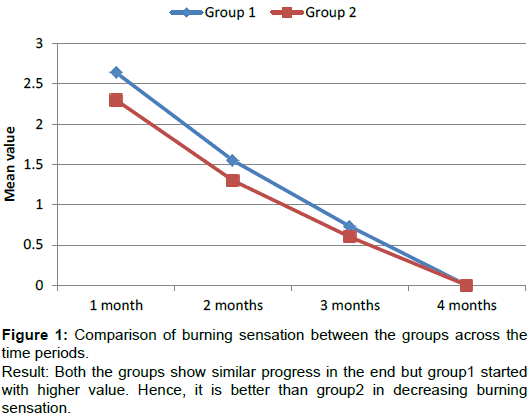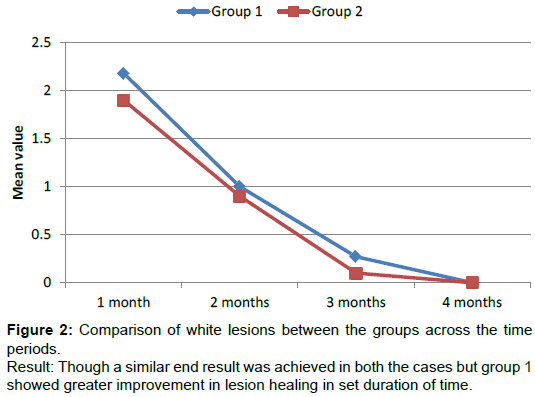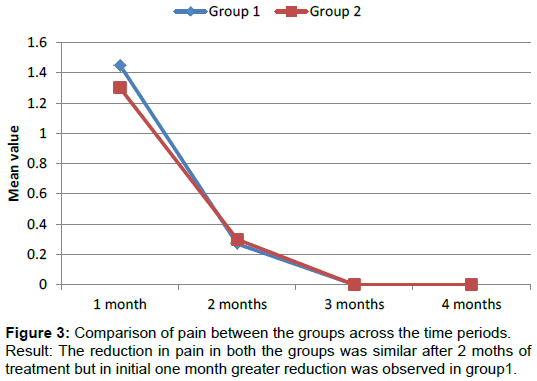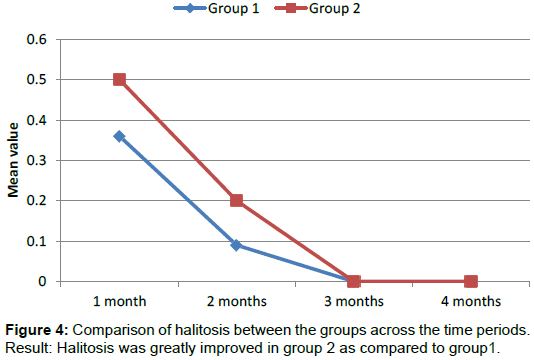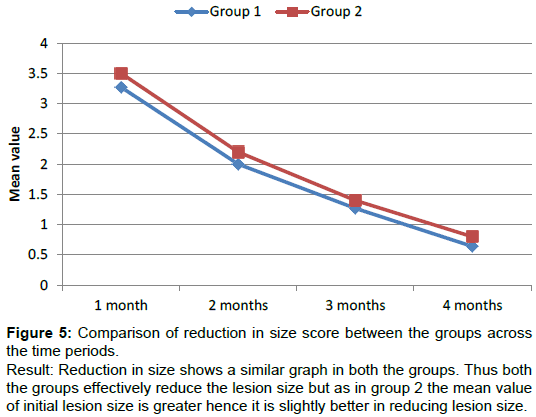Research Article Open Access
Treatment of Lichen Planus: A Comparative Study
Vibha Singh1*, Garima Singh2, Mahesh Pal3 and Kaninika Tandon4
1Department of Oral and Maxillofacial Surgery, K.G. Medical University, Lucknow, India
2Faculty of Dental Sciences, K.G. Medical University, Lucknow, India
3Department of Phytochemistry, N.B.R.I. Lucknow, India
4Resident Faculty of Dental Sciences, Lucknow, India
- *Corresponding Author:
- Vibha Singh
Professor, Department of Oral and Maxillofacial Surgery
K.G. Medical University, Lucknow, India
E-mail: vibhasinghraghuvanshi@gmail.com
Received date: September 21, 2017; Accepted date: September 27, 2017; Published date: October 03, 2017
Citation: Singh V, Singh G, Pal M, Tandon K (2017) Treatment of Lichen Planus: A Comparative Study. J Tradit Med Clin Natur 6:246.
Copyright: © 2017 Singh V, et al. This is an open-access article distributed under the terms of the Creative Commons Attribution License, which permits unrestricted use, distribution, and reproduction in any medium, provided the original author and source are credited.
Visit for more related articles at Journal of Traditional Medicine & Clinical Naturopathy
Abstract
Introduction: Lichen planus is a relatively common disorder, estimated to affect 0.5% to 2.0% of the general population. It is a chronic inflammatory disease affecting mucosal and cutaneous tissue. Oral lichen planus occurs more frequently than the cutaneous form and tends to be more resistant to any treatment.
Material and methods: This study was conducted in Department of Oral Maxillofacial Surgery. Patients in study who were clinically diagnosed and histo- pathologically confirmed as patients of oral lichen planus, were included in the study, Informed consent was taken from all patients. The extract of Turmeric and Tulsi with glycerine base in ointment form was made at National Botanical research institute Lucknow. It was used for local application twice/day for a period of 3 months. Exclusion criteria included systemic diseases and pregnancy. All the patients were divided into two groups, first group was treated with turmeric and second group was treated with Tulsi. All the patient were instructed to report after every 2 weeks for check up and to collect ointment. Evaluation was done on the basis of clinical symptoms like burning sensation, intolerance to spicy food, redness, ulceration, strai and pain. The data was collected, tabulated and analyzed.
Results: Our results shows significant improvement in all clinical features of the lichen planus. Tulsi shows better result in halitosis. On other hand Turmeric is better in reducing burning sensation, pain and white lesions.
Conclusion: Turmeric and Tulsi both are effective in management of Oral lichen planus but turmeric is more effective in reducing burning sensation, pain and white lesions compared to Tulsi.
Keywords
Lichen planus; Turmeric; Tulsi
Introduction
Oral Lichen Planus is a common mucocutaneous disease. It was first described by Wilson in 1869 and is thought to affect 0.5-1% of the world’s population. The condition can affect either the skin or mucosa or both. It can cause bilateral white striations, papules or plaque on the buccal mucosa, tongue and gingiva. Erythrema, erosions and blisters may or may not be present. The involvement of oral mucous membrane is so frequent and accompanies or precedes the appearance of lesions on the skin and genital mucous membrane. Oral lichen planus is T – cell mediated autoimmune diseas in which the auto-cytotoxic CD+T cells trigger apoptosis of the basal cells of the oral epithelium.
As early event in the disease mechanism involves keratinocyte antigen expression or unmasking of an antigen that may be self – peptide or a heat shock protein following this T cells (mostely CD8+ and some CD4+ cells ) migrate in to the epithelium either due to random encounter of antigen during surveillance or a chemokine –mediated migration towards basal keratinocytes. These migrated CD8+ cells are activated directly by an antigen binding to major histocompatibility complex (MCH)-1 on keratinocyte or through activated CD4+ lymphocytes. In addition the number of Langerhans cells in OLP lesions is increased along with upregulation of MCHII expression subsequent antigen presentation to CD4+cells and interlucin (IL)-12 activates CD4+T helper cells which activate CD8+T through receptor interaction, interferon γ (INF-γ) and IL-2. Cells in turn kill the basal keratinocytes through tumor necrosis factor (TNF)α, Fas-FasL –mediated or granzyme B –actvated apoptosis.
The nutritional management of autoimmune diseases usually emphasizes controlling pain and inflammation, slowing the progression of the disease, and boosting the immune system. Few promising foods and nutrients are emerging as potentially beneficial. The use of herbal and dietary supplements is on the rise in patients with autoimmune disease, mainly because they are effective, inexpensive, and relatively safe.
Review of Literature
Oral lichen planus is a common mucocutaneous disease. Bilateral white striation, papules or plaques on buccal mucosa, tongue and gingiva due to apoptosis of oral epithelial cells. It is covered by white grayish line of wickham’s striae. Histopathological finding is hyperparakeratotic or hyperorthokeratotic with thickening of granular layer. Acantholysis with intracellular edema of spinous cells is also seen.
The plant Ocimum sanctum, better known as Tulsi or Holy Basil belongs to family Lamiaceae. It is a tropical plant which grows as weed and also cultivated. It is an erect plant with hairy stems, opposite ovate leaves and purple flowers. It can dry tissue secretions and can penetrate deep tissues and has anti helminthic properties. Also used on swollen parts for it’s anti inflammatory properties. Tulsi leaves act as nervine tonic and help to sharpen memory. Consumption of 10-12 leaves of Tulsi per day helps to reduce stress.
Ocimum tenuiflorum, also known as Ocimum sanctum, holy basil or tulsi, is an aromatic plant in Indian subcontinent. The main chemical constituents of tulsi are oleanolic acid, urosolic acid, rosmarinic acid, eugenol, carvacrol, linalool, beta-elemene. Eugenol is a potent antioxidant help protect heart by controlling blood pressure and lowering cholesterol level. Oleanolic acid and urosolic acid provide the anticancerous property by restricting blood flow to tumor cells by attacking blood vessel supplying it. Tulsi has also been shown to counter metabolic stress through normalization of blood glucose, blood pressure, and lipid levels and psychological stress through positive effect on memory and cognitive function and through its anxiolytic and antidepressant properties. Tulsi is unique combination of pharmacological actions that promote wellbeing and resilience. Adaptogen is the herb that helps with adaptation to stress and promotion of homeostasis is not widely used in western medicine but it revealed that Tulsi does indeed possess many pharmacological actions that fullfil this purpose.
Turmeric is dried rhizome of potential herbs Curcuma longa. The use of turmeric for coloring and flavoring food, for cosmetic purposes and for its medicinal properties dates back to the ancient Vedic culture of India. It is rich in dietary fiber, iron, potassium, magnesium and vitamin B6. The wide range of turmeric health benefits come mainly from its ingredient curcurmin. Curcurmin has immunity boosting and anti-oxidant properties and strong antioxidant which maintains cholesterol levels and puts brakes on aging.
Turmeric is mixed with slaked lime and has been used topically as a treatment for wounds and inflammation of tumour. Angiogenesis is now regarded as critical to transition of premalignant lesion in a hypo proliferative state to malignant phenotype thus facilitating tumour growth and metastasis. Inhibition of angiogenesis by growth factor production integral to the formation of vessels has also been effected by curcumin in non malignant and malignant cells. Curcumin also have immune modulatory effect involving activation of host macrophages and natural killer cells and modulation of lymphocytes mediated function. Curcumin has shown growth inhibitory effect in cancer cell line derived from human prostrate, large intestine and brain and leukemia.
Curcumin is polyphenolic compound isolated from the rhizome of the Curcuma longa that has traditionally been used for pain and wound healing. Recent studies show curcumin ameliorates multiple sclerosis, rheumatoid arthritis, psoriasis and inflammatory bowel disease in human model and animal models. Curcumin inhibits these autoimmune diseases by regulating inflammatory cytokines such as IL-1beta, IL- 12, TNF –gamma and associated JAK-STAT, AP-1, and NF-kappaB signaling pathway in immune cells. Although dietary consumptions of turmeric have beneficial effect at low level the use of purified compound such as curcumin at higher doses needs precaution [1].
Objective
Comparison of Curcuma longa (Turmeric) and Ocimum sanctum (Tulsi) in management of Oral Lichen Planus.
Material and Method
This study was conducted in Department of Oral Maxillofacial Surgery. Patients were included in study who were clinically diagnosed and histo- pathologically confirmed as patients of oral lichen planus, Informed consent was taken from all patients. The extract of Turmeric and Tulsi with glycerine base in ointment form was made at National botinical research institute Lucknow, used for local application twice/ day for a period of 3 months. Exclusion criteria included systemic diseases and pregnancy. All the patients were divided into two groups, first group was treated with turmeric and second group was treated with Tulsi. All the patient were instructed to report after every 2 weeks for checkup and to collect ointment. Evaluation was done on the basis of clinical symptoms like burning sensation, intolerance to spicy food, redness, ulceration, strai and pain. The data was collected, tabulated and analyzed (Tables 1-5).
| Time periods | Group 1 | Group 2 | p-value1 |
|---|---|---|---|
| 1 month | 2.64 ± 0.92 | 2.30 ± 1.25 | 0.48 |
| 2 months | 1.55 ± 0.82 | 1.30 ± 0.94 | 0.53 |
| 3 months | 0.73 ± 0.46 | 0.60 ± 0.51 | 0.56 |
| 4 months | 0.00 ± 0.00 | 0.00 ± 0.00 | - |
Table 1: Comparison of burning sensation between the groups across the time periods.
| Time periods | Group 1 | Group 2 | p-value1 |
|---|---|---|---|
| 1 month | 2.18 ± 0.75 | 1.90 ± 0.56 | 0.34 |
| 2 months | 1.00 ± 0.77 | 0.90 ± 0.56 | 0.74 |
| 3 months | 0.27 ± 0.46 | 0.10 ± 0.31 | 0.33 |
| 4 months | 0.00 ± 0.00 | 0.00 ± 0.00 | - |
Table 2: Comparison of white lesions between the groups across the time periods.
| Time periods | Group 1 | Group 2 | p-value1 |
|---|---|---|---|
| 1 month | 1.45 ± 0.82 | 1.30 ± 0.48 | 0.61 |
| 2 months | 0.27 ± 0.46 | 0.30 ± 0.48 | 0.89 |
| 3 months | 0.00 ± 0.00 | 0.00 ± 0.00 | - |
| 4 months | 0.00 ± 0.00 | 0.00 ± 0.00 | - |
Table 3: Comparison of pain between the groups across the time periods.
| Time periods | Group 1 | Group 2 | p-value1 |
|---|---|---|---|
| 1 month | 0.36 ± 0.67 | 0.50 ± 0.85 | 0.68 |
| 2 months | 0.09 ± 0.30 | 0.20 ± 0.42 | 0.50 |
| 3 months | 0.00 ± 0.00 | 0.00 ± 0.00 | - |
| 4 months | 0.00 ± 0.00 | 0.00 ± 0.00 | - |
Table 4: Comparison of halitosis between the groups across the time periods.
| Time periods | Group 1 | Group 2 | p-value1 |
|---|---|---|---|
| 1 month | 3.27 ± 1.10 | 3.50 ± 0.85 | 0.60 |
| 2 months | 2.00 ± 1.26 | 2.20 ± 1.13 | 0.70 |
| 3 months | 1.27 ± 1.10 | 1.40 ± 1.07 | 0.79 |
| 4 months | 0.64 ± 0.92 | 0.80 ± 0.91 | 0.68 |
Table 5: Comparison of reduction in size score between the groups across the time periods.
Results
Group 1: Turmeric.
Group 2: Ocimum sanctum (Figures 1-5).
Figure 5: Comparison of reduction in size score between the groups across the time periods.
Result: Reduction in size shows a similar graph in both the groups. Thus both the groups effectively reduce the lesion size but as in group 2 the mean value of initial lesion size is greater hence it is slightly better in reducing lesion size.
Statistical Analysis
The results are presented in mean±SD. Mann-Whitney U test was to compare the scores between the groups at different time periods. The p-value<0.05 was considered significant. All the analysis was carried out on SPSS 16.0 version (Chicago, Inc., USA).
Discussion
Steroids have been the drug of choice in the treatment of lichen planus whether topical or systemic their hazards, and side effects are well known. There are certain non steroidal medications that have also been used as alternative but the results are not satisfactory.
Haldi and Tulsi are described in ancient Ayurvedic literatures for their beneficial effects. Ocimum sanctum L. is held sacred by Hindus and is used as medicinal plant in day to day practice in Indian homes for various ailments [2,3].
Turmeric is used in daily food as spices and for religious ceremonies too. Its use as anti-inflammatory, and topical use for wound healing is well known. Curcumin exhibits anti-inflammatory, antiviral, antibacterial, antioxidant and nematocidal activities. It has been shown to suppress tumor initiation, promotion and metastasis. It also inhibit the growth and proliferation of head and neck squamous cell carcinoma by modulating the the constitutive activation of NF-Kb signaling arresting the cells in the G1S phase of cell cycle and activation of upstream and down stream caspases. Prasad S et al. reported clinical improvement in lichen planus patients without any side effect by giving oral curcumin. The dose was initially started at 1 g for 2 weeks and then tapered to 500 mg for 2 weeks. Symptoms and clinical signs disappeared with no adverse effect after the treatment [4]. Singh V et al. conducted study on patients of clinically and histological diagnosed oral lichen planus. Turmeric ointment was given to apply topically 2 times a day for 3 months, significant improvement was observed in clinical symptoms [5].
Both the result are similar to the results observed in our study making Turmeric a potential treatment option for Lichen planus.
Tulsi due to its immunomodulation property can be considered as for treating lichen planus, precancerous lesions and conditions. Polyphenol rosmarinic acid present in tulsi acts as powerful antioxidant. So this property can therapeutically utilized in treating common oral precancerous lesion and conditions like leukoplakia and oral submucous fibrosis. It has antioxidant properties and has significant ability to scavenge highly reactive free radicals. The phenolic compounds cirsilineol, cirsilineol, cirsimaritin, isothymusin, apigenin and rosmarinic acid and appreciable quantities of eugenol from extract of fresh leaves and stems possess good antioxidant activity. According to study conducted by Jai Prakash and S.K. Gupta The seed oil of Ocimum sanctum was evaluated for chemo-preventive activity against subcutaneously injected 20-methylcholanthrene induced fibrosarcoma tumors in the thigh region of Swiss albino mice. Supplementation of maximal tolerated dose (100 ml/kg body weight) of the oil significantly reduced 20-methylcholanthrene induced tumor incidence and tumor volume. The results of this study suggest that the potential chemopreventive activity of the oil is partly attributable to its antioxidant properties [6,7]. These results are seen in animal study and in our study also we find that Tulsi is effective in reducing Lichen planus. Lichen Planus being a precancerous lesion we can say these properties of Tulsi make it a potential treatment option to reduce lichen planus and prevent its maliginant transformation.
Our results also show significant improvement in all clinical features of the lichen planus. Tulsi shows better result in halitosis and reduction in size of the lesion. On other hand Turmeric is better in reducing burning sensation, pain and white lesions. Sreevastava A et al. conducted study by using 1 gram of tulsi paste and 1 gram of turmeric in base of glycerine, and patients with oral submucous fibrosis were asked to apply paste all over the mucosa 4-5 times a day for 15 min, the result showed significant reduction in symptoms of burning sensation and had significant improvement in mouth opening [8,9]. Though the study is done in oral submucous fibrosis patients, but as we see both are precancerous lesions and in both the cases burning sensation has reduced effectively. Hence, we can conclude that our treatment modalities are effective and should be considered.
Conclusion
Turmeric and Tulsi both are effective in management of Oral lichen planus but turmeric is more effective in reducing burning sensation, pain and white lesions compared to Tulsi.
References
- Bright JJ (2007) Curcumin and autoimmune disease. Adv Exp Med 595: 425-451.
- http://twcleansecommunity.com/wp-content/uploads/2014/03/Tulsi-Research-Mohan-Ocimum-sanctum-an-overview.pdf
- Pandey BP, Anita (1990) In: Economic Botany (Published by Chand and Company Ltd., Ramnagar.
- Prasad S, Solanki S, Chinmaya BR, Tandon S, Ashwini B (2014) The magic of herbal curcumin therapy in recurrent oral lichen planus. Am J Ethnomed 1: 96-101
- Singh V (2013) Turmeric - A new treatment option for lichen planus: A pilot study. Natl J Maxillofac Surg 4: 198-201.
- Prakash J, Gupta SK (2000) Chemopreventive activity of Ocimum sanctum seed oil. J Ethnopharmacol 72: 29.
- http://dx.doi.org/10.1016/S0378-8741(00)00194-X
- Srivastava A (2015) Clinical evaluation of the role of tulsi and turmeric in the management of oral submucous fibrosis: A pilot, prospective observational study. J Ayurveda Integr Med 6: 45-9.
- Marc MC (2014) Tulsi –Ocimum sanctum A herb for all reasons. J ayurveda Integr Med 5: 251-259.
Relevant Topics
- Acupuncture Therapy
- Advances in Naturopathic Treatment
- African Traditional Medicine
- Australian Traditional Medicine
- Chinese Acupuncture
- Chinese Medicine
- Clinical Naturopathic Medicine
- Clinical Naturopathy
- Herbal Medicines
- Holistic Cancer Treatment
- Holistic health
- Holistic Nutrition
- Homeopathic Medicine
- Homeopathic Remedies
- Japanese Traditional Medicine
- Korean Traditional Medicine
- Natural Remedies
- Naturopathic Medicine
- Naturopathic Practioner Communications
- Naturopathy
- Naturopathy Clinic Management
- Traditional Asian Medicine
- Traditional medicine
- Traditional Plant Medicine
- UK naturopathy
Recommended Journals
Article Tools
Article Usage
- Total views: 28296
- [From(publication date):
November-2017 - Nov 21, 2024] - Breakdown by view type
- HTML page views : 26823
- PDF downloads : 1473

